Sunday, August 29, 2004
Just don't call it Ping Pong!
To the Man in the Arena
It is not the critic who counts, nor the man who points out how the strong man stumbled, or where the doer of deeds could have done them better. The credit belongs to the man who is actually in the arena; whose face is marred by dust and sweat and blood; who strives valiantly; who errs and comes short again and again; who knows the great enthusiasms, the great devotions, and spends himself in a worthy cause; who, at the best, knows in the end the triumph of high achievement; and who, at worst, if he fails, at least fails while daring greatly, so that his place shall never be with those cold and timid souls who know neither victory nor defeat.
Teddy Roosevelt
Watching the pageantry, heroics and heartbreak of the Olympics in Athens these past number of days has prompted me to reflect a bit on my own brief moments in the Olympics and the world stage. More specifically, I took part in the Paralympics -- for disabled athletes -- in Seoul, South Korea in 1988 and Barcelona, Spain in 1992. Watching a South Korean win the gold medal in Athens in table tennis -- my sport -- from the previously undefeated Chinese, somehow completed the circle for me.
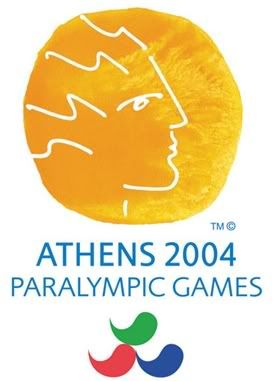
For those not familiar with the distinction, the Paralympics take place immediately following the Olympics for able-bodied athletes, in the same venues, and usually with identical Opening and Closing ceremonies. TV coverage here in the States is still very limited, as the networks seem to feel that their audience is 'Olympics-ed' out (try saying that newly-coined word 3-times fast). There's a bit of an athletic bleed-through however, as certain events for disabled athletes take place during the regular Olympic events, and there are even some disabled athletes who compete on both their Paralympic and Olympic teams, depending upon the sport and the degree of disability.
Although fewer athletes as a whole take part in the Paralympics, it still ranks just behind the Olympics as the largest sporting event in the world, and those sports contested tend to have many more events, as there are multiple classifications of disability represented. For instance, when I competed in the Games, there were 8 classifications of disability within table tennis if I recall correctly....four for wheelchair athletes and four for standing players. I was assigned to the next-to-the-least-disabled classification (more economically referred to as Class 7), due to my right leg being 4-1/2" shorter than my left, as a result of a childhood automobile accident and subsequent surgeries, which necessitates wearing a compensating lift on my right shoe. Someone in the least disabled class might have a permanent injury to the non-playing hand or arm, for example. The physical testing requirements for each class are quite rigorous and detailed in fact, in order to make the competition between each disability within each class as fair as possible.
Although my mobility was limited by my disability, prior to competing in my first National Disabled Championship in order to qualify for the Paralympic team to Seoul, I had always competed against able-bodied TT (table tennis) players and in regular tournaments, such as the U.S. Open. In fact, as a teenager, I gravitated to TT because it put me at less of a disadvantage than most other sports that often required extensive running. Although TT is an incredibly quick sport, by adopting a close-to-the-table attacking style, I was able to minimize the amount of running I needed to do.
My father, Alan, was actually responsible for getting me involved in the sport -- he had been a tennis player -- and built a removable table top that could be placed over our pool table in the rec room. Starting when I was about age 12, we'd 'retire' almost nightly after supper for an hour or two of play. I consequently learned to play the game with tennis strokes, which had to be unlearned in subsequent years when I began to take serious coaching. That first lesson at the hands of a professional came at age 16, when my father and I ventured to the 96th St. TT Club of Marty Reisman, who was one of the very best players in the world in the 1950's, when hard rubber rackets (or bats or paddles -- all interchangeable names) were still in use. Reisman was the odds-on favorite to capture the World Championship in Bombay, India in 1952, but that was the year that an obscure Japanese player named Hiroji Satoh introduced the sponge-rubber racket and changed the sport forever. Suddenly, spins could be produced that no hard-rubber paddle could handle, and Satoh went on to win the World Championship based on a technological advance. Reisman refused to change, and although he would capture the U.S. Championship several times with his old paddle, the international heights could no longer be scaled. He did have the consolation of giving me my very first coaching lesson however. No doubt he's still grateful.
Somehow, that gratitude prompted him to pass my father and I on to someone better prepared to handle the challenge....Sam Hammond from Ghana, who had recently been the West African Champion. I will be forever grateful for that, as how many of us ever have the chance to learn anything at the hands of a Master? Sam had been the youngest West African Champion up to that time, when he dethroned his predecessor -- who had reigned for the better part of a decade. I once asked him about that match and he replied that all he could remember of it was serving the first ball, and the uproarious applause at the end! Observers reported that he 'played out of his mind', which was truer than they'd imagined. In round figures, he had trained 6 hours per day, 6 days a week, for 6 years to rise to that level of mastery. My father and I worked with Sam on and off for several years and he laid the foundation for my training with Chinese and Swedish coaches in the future.
In my mid- and late 20's, I decided to become a bit more serious with my training, to see how far I could go (although working full time at a gourmet coffee and tea shop called Bean's during this period only allowed so much time for the pursuit). By 1986 I was working with a series of American, Chinese and Swedish coaches (China and Sweden were the perennial TT powers at that point...which hasn't changed all that much since then, as 2 Chinese and 1 Swedish player joined the South Korean gold medal winner in the semi-finals of the Athens Olympics). That year I trained with other Olympic hopefuls at the Olympic Training Center in Colorado Springs, and it was about that time that I first heard of the Paralympics for disabled athletes.
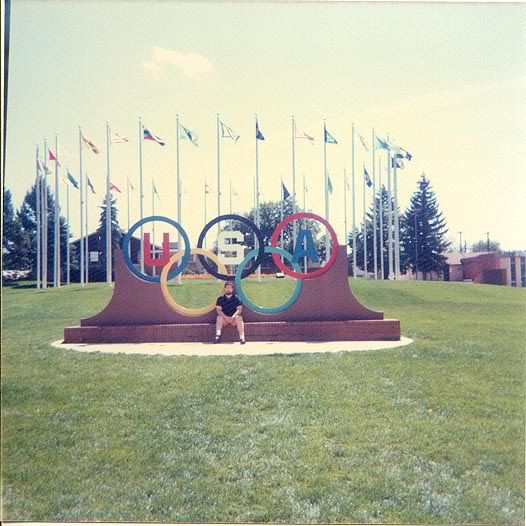
Norman guarding the rings in Colorado Springs
Following up the next year with training at Olympic Training Center in Marquette, Michigan (including both Olympic and Paralympic athletes), I decided that I would enter the National Disabled Championships in Nashville in 1988, to see if I could earn on spot on the team (the 1988 Games in Seoul, South Korea, were to be the first year that table tennis would be included as an Olympic medal sport). When my father passed away in 1987, I decided that I would use a significant portion of my inheritance from him to leave my job for a year in order to train full-time. As he had started me in the game, was my long-time practice partner and biggest supporter in the sport, seriously pursuing my athletic dream seemed the most appropriate way in which to honor his memory.
I was receiving a fair amount of publicity in newspapers and local TV by this point, but it was my main practice partner, Surbek, who rated the front page of the Wall Street Journal. Surbek was the name I gave to the TT robot I'd purchased, in honor of Dragutin Surbek -- my favorite player -- of (then) Yugoslavia. I made use of Surbek when practice partners at my own level were unavailable, to hone certain strokes and to build conditioning (he never seemed to get tired). My coach Sam Hammond once practiced against it and dubbed it 'inhuman', which I thought captured the idea rather succinctly.
The competition at the National Championships in Nashville went well, and I was fortunate enough to capture the gold medal in my category, and as National Disabled Champion was assured a spot on the Paralympic team to Seoul. I wish I could say that I repeated the medal result once there, but the competition in an international venue was of an entirely different order than any I'd experienced here in the States.

Although I had sponsorship from Nike and Stiga, fundraising was always important
Table tennis is not exactly a major sport in the U.S. (I've yet to see a American TT player on a box of Wheaties), but that's not the case in the rest of the world. It's the national sport of the most populous country in the world of course -- China -- and major players in Europe and Asia are national heroes, and compensated accordingly. In fact, TT is the 2nd most popular sport in the world, after soccer (which still has a long way to go on a professional level here in the States).
When one plays in a tournament in the U.S. -- aside from international tournaments such as the U.S. Open -- if there are 30 people watching your match (mostly composed of other players and family), it's remarkable. It was a rather disconcerting experience to have thousands in the stands in Korea. I must admit that I probably spent more time looking around the competition hall with a bemused expression on my face, than I did actually watching the ball during play. Let's just say I didn't record my name in the annals of never-to-be-forgotten matches. It was not a pretty picture.

Norman in the blue

The playing hall during warm-up practice
The overall experience at the Games did paint a pretty picture for me though. The South Korean people were exceptionally warm and hospitable and really went out of their way to meet -- and anticipate -- every need of the athletes and their families. There has been a long-standing cultural tradition in the East that the disabled are largely hidden -- no equivalent to the ADA (Americans with Disabilities Act) is evident in Asia. However, prior to the 1988 Games, the Korean Government launched a massive public-education program designed to help counter centuries of ingrained bigotry, and they were extremely successful. Apparently there was a TV and media blitz for months prior to the event, all focused on showing the disabled in the most positive light, and using as exemplars Paralympic athletes who were not only excelling at their sports at a world-class level, but doing so while overcoming tremendous physical challenges.
As the Games began, I remember regularly encountering Korean volunteers (there were thousands for an event of this size), who showed a slight hesitation at interacting with disabled athletes -- for in many cases they had never encountered a disabled person in public -- but that trepidation quickly dissipated as everyone came to know each other, and as the volunteers began to witness the great feats of personal courage and athletic prowess that were everywhere extant.
An example of that prowess was shown by American Dennis Oehler, who set a new world record of 11.73 seconds in the 100 meter dash on his way to capturing the gold medal. As I recall, that time was equal to, or faster than, any able-bodied college sprinter that year. Dennis did it with an artificial right leg, having lost his below the knee to amputation as a result of an auto accident when he was 24. I was privileged to witness some of the greatest athletes on the planet, who were simultaneously overcoming challenges that able-bodied athletes didn't have to face. I'd never before, nor have I since, been with a more positive group of individuals than those I met in my 2 Paralympic experiences. I'm not sure that I met one person who really thought that they were handicapped in any way. Rather, I encountered people who thrived on facing the biggest physical obstacles that life had to throw at them, and reveling in the added challenges presented. I often felt like a imposter, being there with my disability.
Other great memories include marching into the stadium of 70,000 people with the U.S. team during the Opening Ceremonies (I'm not sure that I can compare that feeling of pride and accomplishment to any other experience in life).
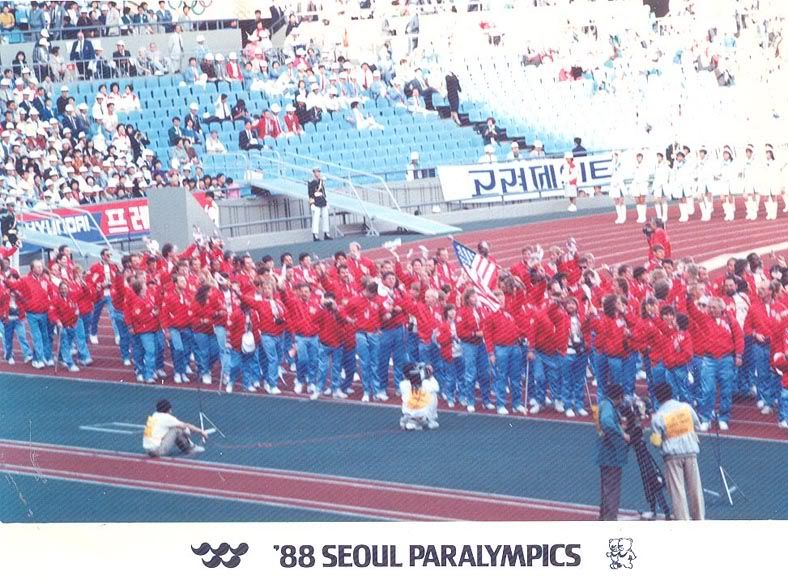
Norman is 3rd or 4th from the right, with beard and white sweatshirt exposed
Another fond memory is that the Koreans gave various schools from around the country time off from classes to attend the Games. Further, in a lovely gesture, they would divide up classes and assign each group to a particular athlete -- no matter the nationality -- so that each competitor had a built-in cheering section. I had my first, and no doubt last experience with signing autographs.
Although my father had passed away the year before the Games, I was most fortunate that my mother, Phyllis, was able make the trip both in 1988, and again in 1992 with my newlywed wife Teresa. After the Games in Seoul, a number of athletes and our families proceeded to tour Hong Kong and Mainland China...but that's another story.
Although returning to the States also meant returning to gainful employment (this time back to the computer field as the CIO of a logistics company), I kept Barcelona in the back of mind, and continued to train and compete in able-bodied tournaments as time allowed. Although my preparation could not be as single-minded as it had been before Seoul, I fortunately had access to David Zhuang at my local club in NJ as a coach. David had recently arrived from China and was making a name for himself at the top of the American TT scene -- where he would eventually win the U.S. Championships several times, represent the U.S. at the Olympic Games after gaining his citizenship, and be named Athlete of the Year on more than one occasion. I also traveled to work with my friend and former personal coach Christian Lillieroos from Sweden, who unbeknownst to either of us at the time, would be named as Head Coach for the 1992 Paralympic Table Tennis Team (he's currently running for President of USATT, the national governing body for the sport).
Between them, I decided I wouldn't make a complete fool of myself in trying out for the team again. This time, the National Championships were being held at Hofstra University on Long Island, NY, and were named the 'Victory Games'. Then Vice President Dan Quayle helicoptered in to offer support to the competitors, and 'potatoe' jokes aside, it was a very nice gesture and gave a lift to all of the athletes (yes, the man with the finger in his ear is a Secret Service agent).

Vice President Dan Quayle with a clean-shaven Norman at the Victory Games
The competition was tougher than it had been in 1988, but with some intensive pre-Games coaching, apparently so was I, and I again managed to capture the gold medal and National Championship in my event.

Receiving Gold Medal at Victory Games
The Games in Barcelona in 1992 ended up being quite a bit better for me -- playing wise -- as with the help of my coach Christian Lillieroos during match play I was able to win a game from the eventual semi-finalist and Bronze Medal winner from the Netherlands. It was not quite as happy an experience for my family however.
My mother and bride traveled together to Spain (already a potentially combustible situation) as part of a large packaged tour group of family members from the United States. Part of the tour package was to include tickets to the Opening Ceremonies, but the group was informed after arriving in Barcelona that the tour company had been unable to obtain the tickets, and no one from the families would be able to attend!
Everyone was understandably crushed by the news, after traveling all the way from the States to see their loved-ones march into the Olympic stadium. Rather than just remaining in their hotel room plotting revenge however, my mother and wife decided to proceed to the stadium and try to get in. At each entrance, ticketless, they were rebuffed by security and had no luck in either buying, borrowing or stealing -- so were left, both crying by this point -- in begging. Apparently, two women alternately voicing "My son....." and "My husband...." between inconsolable sobs remains a universal language, and a kind-hearted guard finally let them in. Being the last two seated in a stadium of 70,000, it wasn't until a bit later while being served champagne that they realized they'd been escorted to the VIP section.
In addition to the wonderful experience of living in the Athletes Village (a huge 24-hour commissary manned by chefs from all over Europe, all free to us, made it hard to break away for competition sometimes), Barcelona itself was a fascinating city to explore. From Antonio Gaudi's Sagrada Familia cathedral, to the Picasso Museum, the topless beach (we never had that in NJ), to the shops along the Rambla (this is where my fountain pen collecting really took off, as it seemed that every other store had a large selection), it was a magical place.

Gaudi's Sagrada Familia cathedral
After leaving Spain following the conclusion of the Games, once more Olympic event took place several months later, when NJ Governor Jim Florio and his wife graciously invited all of the Olympic and Paralympic athletes from the state to lunch at the Governor's mansion. As you can see from the photo below, I'd spent a bit more time in the commissary in Barcelona than had been strictly necessary.

Although I had certainly hoped to try out for one more Paralympic Team, to play before the 'home field' crowds in Atlanta in 1996, within a year or so of returning from Barcelona I had two falls (one caused by rain, the other by snow). The first re-broke my right patella, which had been my original injury at age 6, and the second snapped my right ankle. That, and the responsibilities of running my own business beginning in 1997, have left me with the greatest of memories of my time 'in the Arena', rekindled every 4 years, as now.
Oh, and just follow the link if you want to know why you shouldn't call it ping pong!
Friday, August 27, 2004
Wednesday, August 25, 2004
Japan rules ex-chess champ no refugee, orders him out
HoustonChronicle.com - Bobby Fischer files appeal to delay deportation: "Japan rules ex-chess champ no refugee, orders him out"
Monday, August 23, 2004
Genghis Khan's Pen as Mighty as His Sword?
Ummmm....I vote for "no".
South Korean wins men’s gold in table tennis
Although ranked #3 in the world, this is still considered a major upset, as China has won *all* of the golds since Table Tennis became an Olympic sport in 1988.
Sunday, August 22, 2004
Philadelphia Inquirer | 08/17/2004 | Bob Dylan ranked with Shakespeare
The Master. Period.
NBCOlympics.com - Table Tennis - Inside The Sport
Although one has to generally get up at 4:00 AM to catch any of the matches (!), NBC's web coverage brings back many memories for me of my competitions at Seoul in '88 and Barcelona in '92. More about that anon.
Saturday, August 21, 2004
Friday, August 20, 2004
Japanese Court Dismisses Fischer Request
Excite News: "Japanese Court Dismisses Fischer Request"
Wednesday, August 18, 2004
The New York Times > Business > Your Money > Spending: Sometimes, the Collectible Is Mightier Than the Sword
An article about fountain pens from July 25, 2004. You may have to 'join' (free) the Times to read it, I'm not sure.
A scientific approach to managing competition - The Industrial Physicist
An interesting use of the Volterra-Lotka model, applied to the competition (or lack thereof) between ballpoints and fountain pens. Quoting directly from the article by Theodore Modis in The Industrial Physicist:
Battle of the pens
The struggle between fountain pens and ballpoint pens had a different ending (Figure 1, left). The substitution of ballpoint pens for fountain pens as writing instruments went through three distinct stages. Before the appearance of ballpoint pens, fountainpen sales grew undisturbed to fill the writing- instrument market. They were following an S-shaped curve when the ballpoint technology appeared in 1951. As ballpoint sales picked up, those of fountain pens declined in the period 1951 to 1973. Fountain pens staged a counterattack by radically dropping prices. But that effort failed. Fountain pens kept losing market share and embarked on an extinction course. By 1973, their average price had dropped to as low as 72 cents, to no avail.
Eventually, however, the prices of fountain pens began rising. The fountain pen underwent what Darwin would have described as a character displacement to the luxury niche of the executive pen market. In the early 1970s, the strategy of fountain pens became a retreat into noncompetition. By 1988, the price of some fountain pens in the United States had climbed to $400. The Volterra-Lotka model indicates that today the two species no longer interact but each follows a simple S-shaped growth pattern. As a consequence, fountain pens have secured a healthy and profitable market niche. Had they persisted in their competition with ballpoint pens, they would have perished.
Back from D.C.
Teresa and I have returned from the D.C. pen show. Billed as the 'Supershow', it seemed to have once again lived up to that billing!
There seemed to have been more than 200 dealers present, and the customer traffic was very heavy. We had a very good show, sales-wise (almost a doubling from last year), and had a great time meeting up with old friends and making a few new ones.
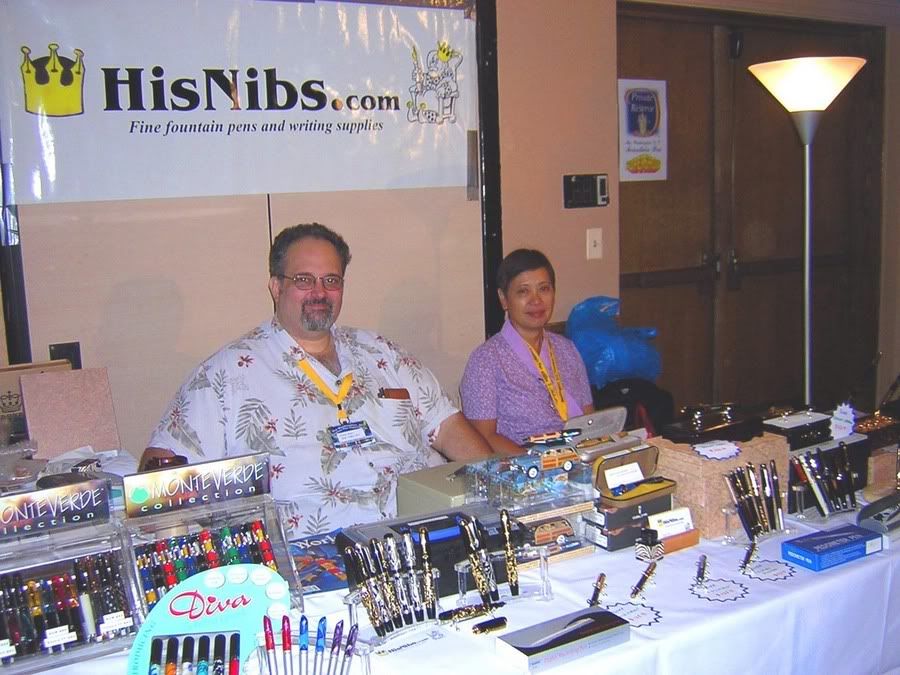
There seemed to have been more than 200 dealers present, and the customer traffic was very heavy. We had a very good show, sales-wise (almost a doubling from last year), and had a great time meeting up with old friends and making a few new ones.

Tuesday, August 17, 2004
Fischer's Fiancee: Marriage Plans Genuine
Excite News: "Fischer's Fiancee: Marriage Plans Genuine"
Monday, August 16, 2004
Fischer Seeks Help Renouncing Citizenship
Excite News: "Fischer Seeks Help Renouncing Citizenship"
Wednesday, August 11, 2004
Beam me in, Scotty
Audio version of essay, Part 1, Part 2 and Part 3
As I prepare to leave next week for the D.C. Pen Show, packing the Delta Dolphin fountain pens has reminded me just how large an influence our oceanic cousins have played in my thoughts over the course of my life. I don't stock many Delta pens as a rule, but when the latest addition to their Animals series was announced (joining the Crocodile, Elephant and Polar Bear), I just couldn't help myself.
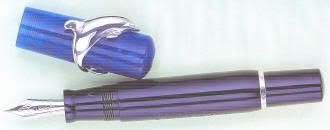
Delta Dolphin pen
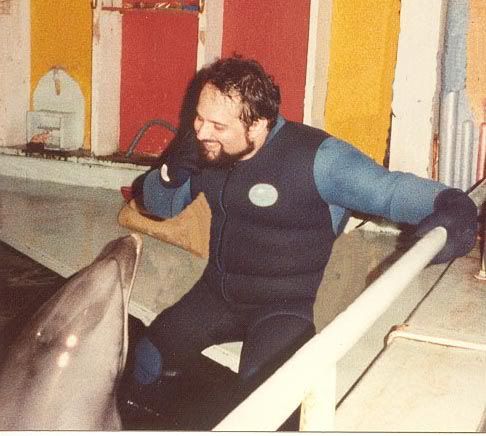
As I prepare to leave next week for the D.C. Pen Show, packing the Delta Dolphin fountain pens has reminded me just how large an influence our oceanic cousins have played in my thoughts over the course of my life. I don't stock many Delta pens as a rule, but when the latest addition to their Animals series was announced (joining the Crocodile, Elephant and Polar Bear), I just couldn't help myself.

Delta Dolphin pen
Dolphins captured my attention early on, primarily due to the research of Dr. John Lilly in the 1950's, who wrote a number of fascinating books on the subject of dolphin intelligence and interspecies communication (he largely worked with Tursiops Truncatus, the Bottle-nosed dolphin, familiar to many as the star of the Flipper TV series in the 60's). Although superseded by other researchers and more recent work, there's still great value in returning to some of those original reports that grew out of Lilly's work for the U.S. Navy, in books such as Communication Between Man and Dolphin.
Growing up, I voraciously read anything I could lay claim to on the subject of Cetaceans (dolphins, porpoises and whales) and would watch aquarium dolphin 'shows' -- whether live or on TV -- whenever possible. Several dolphin "trainers" (something of a misnomer, as often it's the dolphin that seems to be training the human) suggested that I might want to pursue that occupation, but by then I couldn't see myself working with captured dolphins. Lilly progressed from initially 'sacrificing' (the polite term used in medicine and biology to replace 'killing') dolphins in order to autopsy them and examine their brain structure in detail, to later refusing to continue his work until a facility could be constructed where the dolphins were free to come and go as they chose (he found that several were as interested in pursuing the cognitive studies as he was!).
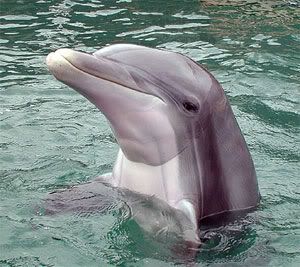
Lilly came to believe that the bottle-nosed dolphin was at least as intelligent as homo sapiens - having a 30% larger brain, with a neocortex as complex as our own, routinely processing about 2-1/2 times the amount of sensory information per second that we do (more often acoustical than visual, due to their amazing echo-location) and solving intricate social and cognitive challenges - often more quickly than the human participants. It's quite telling that the attempts at interspecies communication through language acquisition have been most successful when it's the dolphin learning our language. Many of Lilly's seemingly outrageous claims -- such as that the most advanced minds on the planet belong to whales (the sperm whale has a brain of apparently equal complexity to our own, as measured by neuronal density and depth of neocortical creases or convolutions -- but is 6 times larger) -- leave many marine biologists amused at best. However there is also a growing body of evidence from other researchers that appears to corroborate many of his suppositions and anecdotal accounts.
I'll leave Lilly's later researches into human consciousness through psychotropic drugs and sensory deprivation -- with himself as the test subject -- for another time, but books such as The Center of the Cyclone and Programming and Metaprogramming in the Human Biocomputer make for equally engrossing reading.
In the mid-80's I finally had the opportunity to have a close encounter of the dolphin kind, for myself. Although I'm not sure that it's still in existence, at that time there was a marine mammal rescue and research center in West Dennis, on Cape Cod, MA, which I had discovered on one of my trips to the Cape to visit my friend Joannie, who lived in nearby Chatham. They had a program at that time, in order to raise funds for research and rescue, that consisted of a two-hour lecture on Cetacean biology, followed by a swim with a rescued bottle-nosed dolphin named Scotty (I'm sure that must have been the name he gave them).
This was a number of years prior to the widespread 'swims' adopted by Seaquariums, employing their captive, performing dolphins. As Scotty was a rescued animal, being nursed back to health for eventual release 'home', the large tank that was his temporary abode was fed fresh seawater directly from the bay for his comfort -- not ours. Consequently, any humans entering the tank for a tete-a-tete with Scotty were exposed to the chill Cape Cod water, necessitating the use of a wetsuit.
My first experience in a wetsuit was an experience. Just getting into one of these things takes time, strength, patience and copious amounts of baby powder. Once in the water, I quickly learned that these things are buoyant -- from neck to ankle. If you want to just wade in the water, legs down doesn't do it (that tends to flip you on your back). You have to actually assume a sitting position underwater in order to maintain an upright posture with your head out.
But I'm getting slightly ahead of myself, for actually getting into the water with Scotty produced a moment's trepidation. Here was a wild animal, weighing in at about 450 lbs., in his environment, and as far as I knew my invitation to join the swimming party hadn't been cleared with him. If he decided that I wasn't welcome, it would have been nothing for him to have flipped me out (pun intended), despite my not inconsiderable bulk. Or, raking me with his exceedingly sharp teeth would have also spoiled my day (dolphins routinely kill sharks in the wild, usually by ramming their gills at high speed with their 'beak' and lower jaw).
Yet, all that I knew intellectually about the species quickly allayed those fears. The recorded history of man/dolphin interaction, going back thousands of years and continuing today, almost unfailingly demonstrate the dolphin's keen interest in, and benevolence toward, his two-legged cousin. The anecdotes and documented cases of wild dolphins coming to the aid of shipwrecked sailors and people near to drowning, are legion. It's as if they can directly sense a kindred intellect and spirit, and go out of their way to protect us (driving off sharks, as an example). And those senses are acute.
Within seconds of entering the large tank, even before I had seen the submerged dolphin, Scotty made his presence known to me -- as I felt a tingling sensation traverse my body -- head-to-toe. That tingling was produced by Scotty directing his 'sonar', or more properly 'echo-location clicks' which not only told him my precise location, but also informed him of my respiration, heart-rate and other bodily functions -- which quite probably gave him a fair idea of my emotional state. Dolphins are highly social beings, and apparently rely a great deal on these non-verbal signals to gauge the status of another's emotions, much as we rely upon similar visual clues. However, Scotty knew a lot more about me in those first few seconds than I could discern about him.
He also subsequently showed great interest in my shorter right leg (a result of a childhood automobile accident and corrective surgeries), by the prolonged attention he exhibited to that area of my anatomy, both with directed echo-location and close visual inspection. Dolphins have a penchant for being most attentive in human/dolphin interactions to those individuals who seem 'different' or injured, and whole swim programs have been developed around the extreme gentleness and approachability they exhibit toward physically, emotionally or mentally challenged children and adults.
As the swim progressed (I had snorkle gear, which allowed me to peer at Scotty underwater as well) I removed one of my neoprene gloves to stroke Scotty on one of his passes. The closest approximation I've been able to come to in describing the feeling of his skin and body underneath my fingertips was that of a 450 lb. hard-boiled egg (minus the shell, thank you). But the real highlight of the experience for me was to stare eye-to-eye with him. After all my years of reading and study concerning the nature of cetacean intelligence, I had no intellectual doubts about its high order. It wasn't until I looked into Scotty's eye, and he looked back however, that I knew I was sharing a basic level of communication with another intelligent being, quite possibly one that functioned in a mental world not too unlike the one that I and my fellow humans inhabit. I felt profoundly grateful for that moment of silent communion -- as well as the forebearance he showed during my early flailing around in his 'home' as I got used to the bouyant wetsuit (I was later told that I'd actually kicked Scotty in the head during my aquatic struggles!). Our search for extraterrestrial intelligence continues, but I am satisfied that we know of at least one other intelligence in the Cosmos on a rough par with our own, and taking into account the great whales, perhaps greater than our own -- but that's another story.
The photo below was one of a series taken immediately after my swim, as Scotty emerged from the tank to plant a farewell kiss on my cheek.
Growing up, I voraciously read anything I could lay claim to on the subject of Cetaceans (dolphins, porpoises and whales) and would watch aquarium dolphin 'shows' -- whether live or on TV -- whenever possible. Several dolphin "trainers" (something of a misnomer, as often it's the dolphin that seems to be training the human) suggested that I might want to pursue that occupation, but by then I couldn't see myself working with captured dolphins. Lilly progressed from initially 'sacrificing' (the polite term used in medicine and biology to replace 'killing') dolphins in order to autopsy them and examine their brain structure in detail, to later refusing to continue his work until a facility could be constructed where the dolphins were free to come and go as they chose (he found that several were as interested in pursuing the cognitive studies as he was!).

Lilly came to believe that the bottle-nosed dolphin was at least as intelligent as homo sapiens - having a 30% larger brain, with a neocortex as complex as our own, routinely processing about 2-1/2 times the amount of sensory information per second that we do (more often acoustical than visual, due to their amazing echo-location) and solving intricate social and cognitive challenges - often more quickly than the human participants. It's quite telling that the attempts at interspecies communication through language acquisition have been most successful when it's the dolphin learning our language. Many of Lilly's seemingly outrageous claims -- such as that the most advanced minds on the planet belong to whales (the sperm whale has a brain of apparently equal complexity to our own, as measured by neuronal density and depth of neocortical creases or convolutions -- but is 6 times larger) -- leave many marine biologists amused at best. However there is also a growing body of evidence from other researchers that appears to corroborate many of his suppositions and anecdotal accounts.
I'll leave Lilly's later researches into human consciousness through psychotropic drugs and sensory deprivation -- with himself as the test subject -- for another time, but books such as The Center of the Cyclone and Programming and Metaprogramming in the Human Biocomputer make for equally engrossing reading.
In the mid-80's I finally had the opportunity to have a close encounter of the dolphin kind, for myself. Although I'm not sure that it's still in existence, at that time there was a marine mammal rescue and research center in West Dennis, on Cape Cod, MA, which I had discovered on one of my trips to the Cape to visit my friend Joannie, who lived in nearby Chatham. They had a program at that time, in order to raise funds for research and rescue, that consisted of a two-hour lecture on Cetacean biology, followed by a swim with a rescued bottle-nosed dolphin named Scotty (I'm sure that must have been the name he gave them).
This was a number of years prior to the widespread 'swims' adopted by Seaquariums, employing their captive, performing dolphins. As Scotty was a rescued animal, being nursed back to health for eventual release 'home', the large tank that was his temporary abode was fed fresh seawater directly from the bay for his comfort -- not ours. Consequently, any humans entering the tank for a tete-a-tete with Scotty were exposed to the chill Cape Cod water, necessitating the use of a wetsuit.
My first experience in a wetsuit was an experience. Just getting into one of these things takes time, strength, patience and copious amounts of baby powder. Once in the water, I quickly learned that these things are buoyant -- from neck to ankle. If you want to just wade in the water, legs down doesn't do it (that tends to flip you on your back). You have to actually assume a sitting position underwater in order to maintain an upright posture with your head out.
But I'm getting slightly ahead of myself, for actually getting into the water with Scotty produced a moment's trepidation. Here was a wild animal, weighing in at about 450 lbs., in his environment, and as far as I knew my invitation to join the swimming party hadn't been cleared with him. If he decided that I wasn't welcome, it would have been nothing for him to have flipped me out (pun intended), despite my not inconsiderable bulk. Or, raking me with his exceedingly sharp teeth would have also spoiled my day (dolphins routinely kill sharks in the wild, usually by ramming their gills at high speed with their 'beak' and lower jaw).
Yet, all that I knew intellectually about the species quickly allayed those fears. The recorded history of man/dolphin interaction, going back thousands of years and continuing today, almost unfailingly demonstrate the dolphin's keen interest in, and benevolence toward, his two-legged cousin. The anecdotes and documented cases of wild dolphins coming to the aid of shipwrecked sailors and people near to drowning, are legion. It's as if they can directly sense a kindred intellect and spirit, and go out of their way to protect us (driving off sharks, as an example). And those senses are acute.
Within seconds of entering the large tank, even before I had seen the submerged dolphin, Scotty made his presence known to me -- as I felt a tingling sensation traverse my body -- head-to-toe. That tingling was produced by Scotty directing his 'sonar', or more properly 'echo-location clicks' which not only told him my precise location, but also informed him of my respiration, heart-rate and other bodily functions -- which quite probably gave him a fair idea of my emotional state. Dolphins are highly social beings, and apparently rely a great deal on these non-verbal signals to gauge the status of another's emotions, much as we rely upon similar visual clues. However, Scotty knew a lot more about me in those first few seconds than I could discern about him.
He also subsequently showed great interest in my shorter right leg (a result of a childhood automobile accident and corrective surgeries), by the prolonged attention he exhibited to that area of my anatomy, both with directed echo-location and close visual inspection. Dolphins have a penchant for being most attentive in human/dolphin interactions to those individuals who seem 'different' or injured, and whole swim programs have been developed around the extreme gentleness and approachability they exhibit toward physically, emotionally or mentally challenged children and adults.
As the swim progressed (I had snorkle gear, which allowed me to peer at Scotty underwater as well) I removed one of my neoprene gloves to stroke Scotty on one of his passes. The closest approximation I've been able to come to in describing the feeling of his skin and body underneath my fingertips was that of a 450 lb. hard-boiled egg (minus the shell, thank you). But the real highlight of the experience for me was to stare eye-to-eye with him. After all my years of reading and study concerning the nature of cetacean intelligence, I had no intellectual doubts about its high order. It wasn't until I looked into Scotty's eye, and he looked back however, that I knew I was sharing a basic level of communication with another intelligent being, quite possibly one that functioned in a mental world not too unlike the one that I and my fellow humans inhabit. I felt profoundly grateful for that moment of silent communion -- as well as the forebearance he showed during my early flailing around in his 'home' as I got used to the bouyant wetsuit (I was later told that I'd actually kicked Scotty in the head during my aquatic struggles!). Our search for extraterrestrial intelligence continues, but I am satisfied that we know of at least one other intelligence in the Cosmos on a rough par with our own, and taking into account the great whales, perhaps greater than our own -- but that's another story.
The photo below was one of a series taken immediately after my swim, as Scotty emerged from the tank to plant a farewell kiss on my cheek.

Tuesday, August 10, 2004
Sunday, August 08, 2004
Science secret of grand masters revealed
This 'secret' struck me as being rather self-evident to anyone that has played much chess, but an interesting article still.
Labels:
chess
Friday, August 06, 2004
Wednesday, August 04, 2004
Tuesday, August 03, 2004
Fischer's Beliefs May Limit His Options
Excite News: "
Fischer's Beliefs May Limit His Options"
Fischer's Beliefs May Limit His Options"
Monday, August 02, 2004
Subscribe to:
Posts (Atom)



